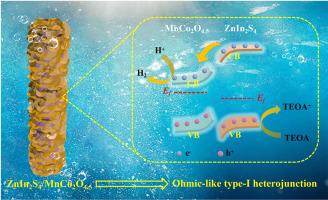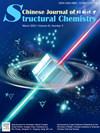Type-I heterojunction photocatalysis: Enhanced activity via ZnIn2S4/MnCo2O4.5 interfacial electric fields
IF 10.3
4区 化学
Q1 CHEMISTRY, INORGANIC & NUCLEAR
引用次数: 0
Abstract
The modulation of charge transfer pathways within type-I heterojunctions through interfacial electric field (IEF) engineering is of critical importance in promoting photocatalytic hydrogen evolution, effectively facilitating the separation of photogenerated charge carriers. In this study, we performed in-situ growth of two-dimensional ZnIn2S4 nanosheets on MnCo2O4.5 nanorods to construct an ohmic-like type-I ZnIn2S4/MnCo2O4.5 heterojunction for efficient photocatalytic hydrogen evolution. This ohmic-like charge transfer mechanism effectively addresses the intrinsic limitations inherent to conventional type-I heterojunctions neglecting IEF effects, particularly through IEF-induced enhancement of charge separation efficiency. Consequently, the optimized ZnIn2S4/MnCo2O4.5 photocatalyst demonstrates an outstanding photocatalytic hydrogen evolution rate of 20.9 mmol g−1 h−1, 14.9 times that of the bare ZnIn2S4. Furthermore, the ohmic-like charge transport behavior has been rigorously validated by integrated advanced experimental characterizations, including in-situ X-ray photoelectron spectroscopy (XPS), Kelvin probe force microscopy (KPFM), and surface photovoltage (SPV) measurements, which collectively provide robust evidence for the proposed mechanism. This work offers valuable insights into the design of high-efficient ohmic-like type-I heterojunction catalysts for photocatalytic H2 evolution.

i型异质结光催化:ZnIn2S4/MnCo2O4.5界面电场增强活性
通过界面电场(IEF)工程调制i型异质结内的电荷转移途径对于促进光催化析氢,有效地促进光生载流子的分离具有至关重要的意义。在这项研究中,我们在MnCo2O4.5纳米棒上原位生长了二维ZnIn2S4纳米片,构建了一个类似欧姆的i型ZnIn2S4/MnCo2O4.5异质结,用于高效的光催化析氢。这种类欧姆电荷转移机制有效地解决了传统i型异质结忽略IEF效应的固有局限性,特别是通过IEF诱导的电荷分离效率的增强。结果表明,优化后的ZnIn2S4/MnCo2O4.5光催化剂的光催化析氢速率为20.9 mmol g−1 h−1,是裸ZnIn2S4的14.9倍。此外,类欧姆电荷输运行为已经通过集成的先进实验表征得到严格验证,包括原位x射线光电子能谱(XPS),开尔文探针力显微镜(KPFM)和表面光电压(SPV)测量,这些都为所提出的机制提供了有力的证据。这项工作为设计用于光催化氢演化的高效类欧姆i型异质结催化剂提供了有价值的见解。
本文章由计算机程序翻译,如有差异,请以英文原文为准。
求助全文
约1分钟内获得全文
求助全文
来源期刊

结构化学
化学-晶体学
CiteScore
4.70
自引率
22.70%
发文量
5334
审稿时长
13 days
期刊介绍:
Chinese Journal of Structural Chemistry “JIEGOU HUAXUE ”, an academic journal consisting of reviews, articles, communications and notes, provides a forum for the reporting and discussion of current novel research achievements in the fields of structural chemistry, crystallography, spectroscopy, quantum chemistry, pharmaceutical chemistry, biochemistry, material science, etc. Structural Chemistry has been indexed by SCI, CA, and some other prestigious publications.
 求助内容:
求助内容: 应助结果提醒方式:
应助结果提醒方式:


